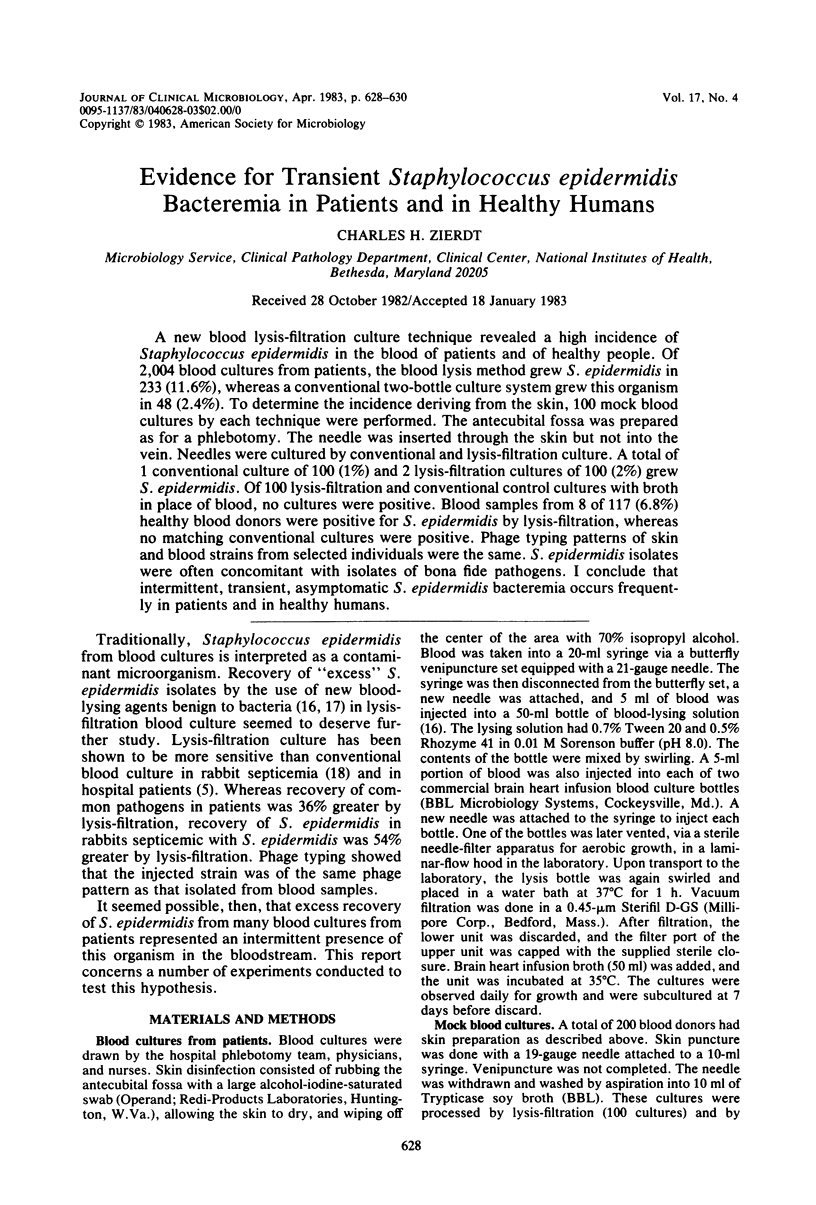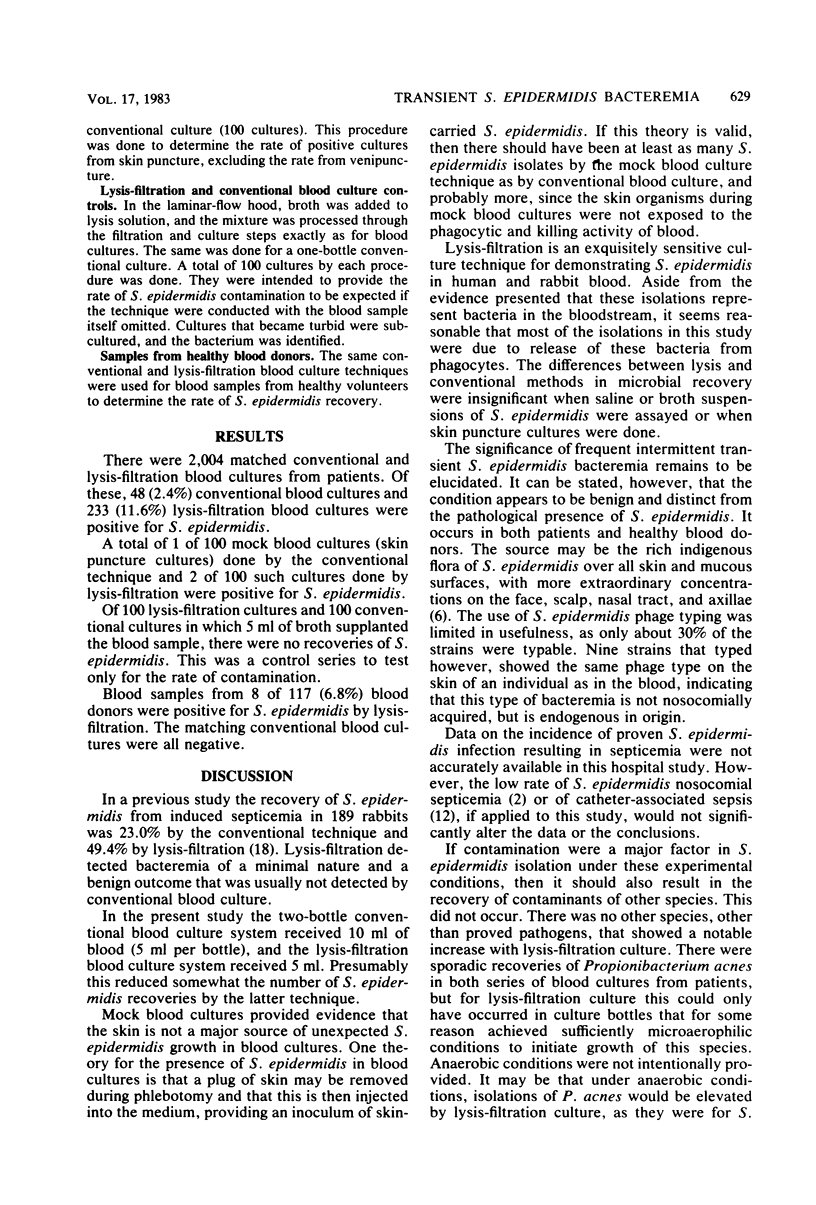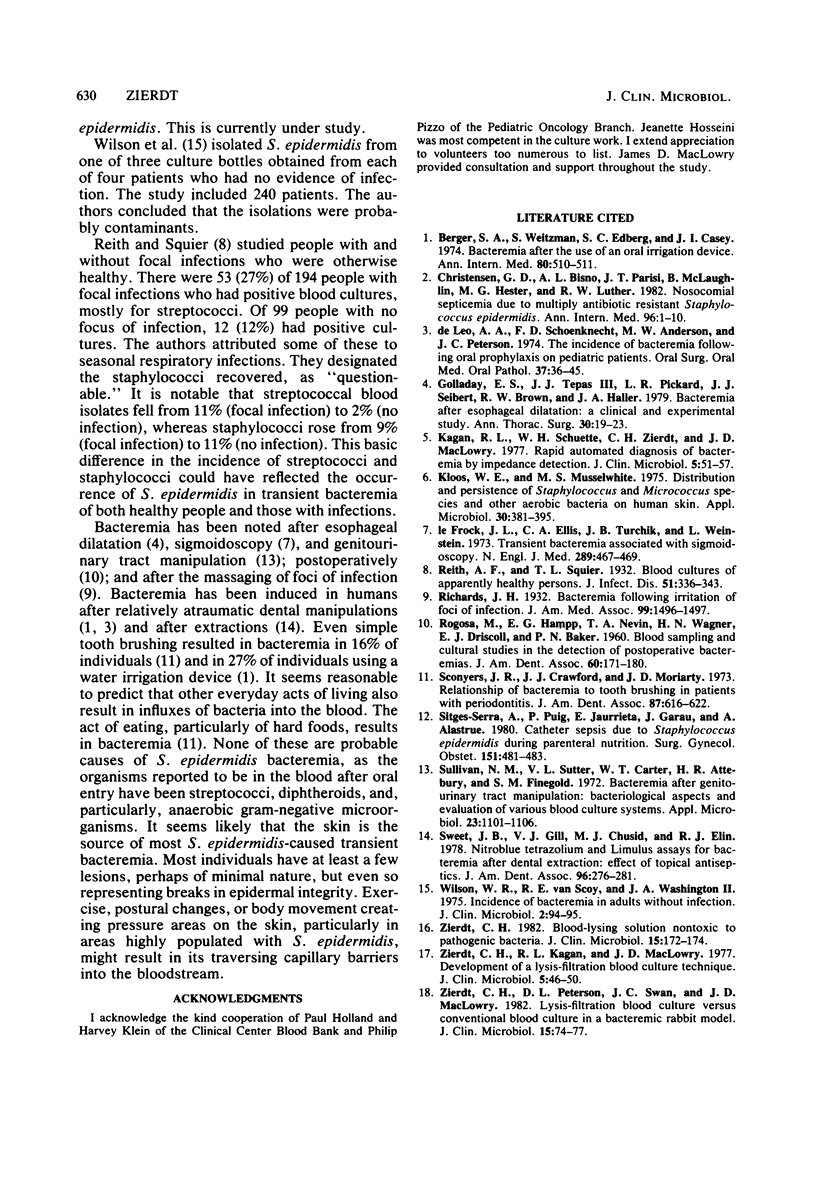Abstract
A new blood lysis-filtration culture technique revealed a high incidence of Staphylococcus epidermidis in the blood of patients and of healthy people. Of 2,004 blood cultures from patients, the blood lysis method grew S. epidermidis in 233 (11.6%), whereas a conventional two-bottle culture system grew this organism in 48 (2.4%). To determine the incidence deriving from the skin, 100 mock blood cultures by each technique were performed. The antecubital fossa was prepared as for a phlebotomy. The needle was inserted through the skin but not into the vein. Needles were cultured by conventional and lysis-filtration culture. A total of 1 conventional culture of 100 (1%) and 2 lysis-filtration cultures of 100 (2%) grew S. epidermidis. Of 100 lysis-filtration and conventional control cultures with broth in place of blood, no cultures were positive. Blood samples from 8 of 117 (6.8%) healthy blood donors were positive for S. epidermidis by lysis-filtration, whereas no matching conventional cultures were positive. Phage typing patterns of skin and blood strains from selected individuals were the same. S. epidermidis isolates were often concomitant with isolates of bona fide pathogens. I conclude that intermittent, transient, asymptomatic S. epidermidis bacteremia occurs frequently in patients and in healthy humans.
Full text
PDF


Selected References
These references are in PubMed. This may not be the complete list of references from this article.
- Berger S. A., Weitzman S., Edberg S. C., Casey J. I. Bacteremia after the use of an oral irrigation device. A controlled study in subjects with normal-appearing gingiva: comparison with use of toothbrush. Ann Intern Med. 1974 Apr;80(4):510–511. doi: 10.7326/0003-4819-80-4-510. [DOI] [PubMed] [Google Scholar]
- Christensen G. D., Bisno A. L., Parisi J. T., McLaughlin B., Hester M. G., Luther R. W. Nosocomial septicemia due to multiply antibiotic-resistant Staphylococcus epidermidis. Ann Intern Med. 1982 Jan;96(1):1–10. doi: 10.7326/0003-4819-96-1-1. [DOI] [PubMed] [Google Scholar]
- De Leo A. A., Schoenknecht F. D., Anderson M. W., Peterson J. C. The incidence of bacteremia following oral prophylaxis on pediatric patients. Oral Surg Oral Med Oral Pathol. 1974 Jan;37(1):36–45. doi: 10.1016/0030-4220(74)90157-1. [DOI] [PubMed] [Google Scholar]
- Golladay E. S., Tepas J. J., 3rd, Pickard L. R., Seibert J. J., Brown R. W., Haller J. A., Jr Bacteremia after esophageal dilation: a clinical and experimental study. Ann Thorac Surg. 1980 Jul;30(1):19–23. doi: 10.1016/s0003-4975(10)61196-4. [DOI] [PubMed] [Google Scholar]
- Kagan R. L., Schuette W. H., Zierdt C. H., MacLowry J. D. Rapid automated disgnosis of bacteremia by impedance detection. J Clin Microbiol. 1977 Jan;5(1):51–57. doi: 10.1128/jcm.5.1.51-57.1977. [DOI] [PMC free article] [PubMed] [Google Scholar]
- Kloos W. E., Musselwhite M. S. Distribution and persistence of Staphylococcus and Micrococcus species and other aerobic bacteria on human skin. Appl Microbiol. 1975 Sep;30(3):381–385. doi: 10.1128/am.30.3.381-395.1975. [DOI] [PMC free article] [PubMed] [Google Scholar]
- LeFrock J. L., Ellis C. A., Turchik J. B., Weinstein L. Transient bacteremia associated with sigmoidoscopy. N Engl J Med. 1973 Aug 30;289(9):467–469. doi: 10.1056/NEJM197308302890908. [DOI] [PubMed] [Google Scholar]
- ROGOSA M., HAMPP E. G., NEVIN T. A., WAGNER H. N., Jr, DRISCOLL E. J., BAER P. N. Blood sampling and cultural studies in the detection of postoperative bacteremias. J Am Dent Assoc. 1960 Feb;60:171–180. doi: 10.14219/jada.archive.1960.0030. [DOI] [PubMed] [Google Scholar]
- Sconyers J. R., Crawford J. J., Moriarty J. D. Relationship of bacteremia to toothbrushing in patients with periodontitis. J Am Dent Assoc. 1973 Sep;87(3):616–622. doi: 10.14219/jada.archive.1973.0453. [DOI] [PubMed] [Google Scholar]
- Sitges-Serra A., Puig P., Jaurrieta E., Garau J., Alastrue A., Sitges-Creus A. Catheter sepsis due to Staphylococcus epidermidis during parenteral nutrition. Surg Gynecol Obstet. 1980 Oct;151(4):481–483. [PubMed] [Google Scholar]
- Sullivan N. M., Sutter V. L., Carter W. T., Attebery H. R., Finegold S. M. Bacteremia after genitourinary tract manipulation: bacteriological aspects and evaluation of various blood culture systems. Appl Microbiol. 1972 Jun;23(6):1101–1106. doi: 10.1128/am.23.6.1101-1106.1972. [DOI] [PMC free article] [PubMed] [Google Scholar]
- Sweet J. B., Gill V. J., Chusid M. J., Elin R. J. Nitroblue tetrazolium and Limulus assays for bacteremia after dental extraction: effect of topical antiseptics. J Am Dent Assoc. 1978 Feb;96(2):276–281. doi: 10.14219/jada.archive.1978.0049. [DOI] [PubMed] [Google Scholar]
- Wilson W. R., Van Scoy R. E., Washington J. A., 2nd Incidence of bacteremia in adults without infection. J Clin Microbiol. 1976 Aug;2(2):94–95. [PMC free article] [PubMed] [Google Scholar]
- Zierdt C. H. Blood-lysing solution nontoxic to pathogenic bacteria. J Clin Microbiol. 1982 Jan;15(1):172–174. doi: 10.1128/jcm.15.1.172-174.1982. [DOI] [PMC free article] [PubMed] [Google Scholar]
- Zierdt C. H., Kagan R. L., MacLowry J. D. Development of a lysis-filtration blood culture technique. J Clin Microbiol. 1977 Jan;5(1):46–50. doi: 10.1128/jcm.5.1.46-50.1977. [DOI] [PMC free article] [PubMed] [Google Scholar]
- Zierdt C. H., Peterson D. L., Swan J. C., MacLowry J. D. Lysis-filtration blood culture versus conventional blood culture in a bacteremic rabbit model. J Clin Microbiol. 1982 Jan;15(1):74–77. doi: 10.1128/jcm.15.1.74-77.1982. [DOI] [PMC free article] [PubMed] [Google Scholar]


